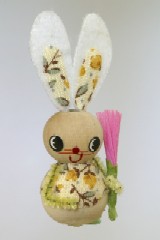Easter Bunny Trivia
Holidays Trivia Have you ever wondered where the Easter Bunny came from? Whose idea was it to have a pink, fuzzy rabbit hide eggs around the yard for children to find anyway? Ask any elementary student and you will quickly learn that rabbits are mammals, and mammals do not lay eggs! Is there a historical reason behind this quirky Easter tradition?
Have you ever wondered where the Easter Bunny came from? Whose idea was it to have a pink, fuzzy rabbit hide eggs around the yard for children to find anyway? Ask any elementary student and you will quickly learn that rabbits are mammals, and mammals do not lay eggs! Is there a historical reason behind this quirky Easter tradition?
The Easter Bunny made his first appearance on the stage of Easter history in the 1500s in Germany. Most holiday historians believe that folklore actually put the symbol and the spring holiday together much earlier, although records no longer exist. From this German rabbit, many other cultures picked up the tradition. The Dutch in Pennsylvania introduced the tradition to the colonies in the United States when they celebrated Easter with their children.
But why is a rabbit so integral to the Easter celebration? The tradition surrounding a spring holiday is built around the cycles of the moon. Most spring holidays were celebrated at specific dates of the moon cycle. The rabbit was known in many ancient cultures as the creature of the moon. The Chinese, for example, believed he lived in the moon, pounding rice. Buddhists also believe there is a rabbit in the moon who was put there as a reward for his selflessness.
In Europe, Celtic traditions pointed to the rabbit as the symbol of fertility. Spring festivals are traditionally a celebration of new life, making the fertility rabbit the perfect icon for the season. Similarly, Germans have a traditional belief that it is rabbits that bring the new life to nature each spring.
Even Native Americans had their own unique rabbit lore relating to spring. They felt the rabbit brought benefits to their people. For example, in Mayan tradition, stories taught that a rabbit brought them written language. Tribes in North America revered the rabbit. There were also many beliefs in him as a jokester. Perhaps this is the origin of his hiding the eggs, rather then delivering them in neat packages to the children.
So when did the Easter Bunny start laying candy eggs? This part of the Easter Bunny tradition actually started in the late 1800s, due to advertising! Easter eggs have a long and beautiful spring holiday history, and a European candy maker wanted to capitalize on the Easter Bunny tradition to sell their candy eggs. They used bunnies and eggs to market their product in such a way that the two seemed to have always gone together. And since the egg, like the rabbit, was an ancient symbol of fertility, the two seemed to fit together even better!
Today’s Easter Bunny seems quite different then the revered creature of ancient times. Yet, he is surprisingly similar. He is the bringer of gifts each spring. With the coming of the loveable lop-eared creature, spring officially begins. Children eagerly await his arrival, perhaps second only to the anticipation of Santa Claus in the winter. While today’s Easter Bunny looks much different from his iconic ancient counterparts, the tradition is a historic one with deep roots. Over the years the bunny evolved into the fluffy pink icon of today’s Easter, who brings a smile to many children’s faces each spring.

A cursory reading of your interesting article revealed the following erratum: in the last paragraph, “…different then the…” should have been spelled “…different than the…”. Actually, the best construction would have been “…different from the…”.
Just as “nor” goes with “neither”, “from” goes with “different”.
Thank you.
Gene
Bayside, WI 53217-176266
Hi Gene,
Thanks for your comments. This has been corrected. Always something to learn 😀